Exploring Blended Teaching and Learning Methods
Explore effective blended teaching and learning methods, combining online and in-person strategies for enhanced educational outcomes.


Explore effective blended teaching and learning methods, combining online and in-person strategies for enhanced educational outcomes.
Blended teaching and learning represent an instructional paradigm that seeks to harness the capacity of digital tools while maintaining the irreplaceable value of face-to-face interaction. It is an approach designed to forge synchronization between online digital strategies and the traditional, time-honored practices found within the regular classroom. At its core, this way of teaching is focused on combining an indispensable human element with technological advancements to enrich the learning experience.
In practical terms, blended instruction might manifest itself through a variety of models. For some, it entails incorporating an online component wherein students engage in tasks or review materials outside of class time, returning to the classroom for in-depth discussion and hands-on activities that build upon the online learning. This approach promises not only to augment the traditional learning model but also to cultivate a more individualized and differentiated learning path for each student.
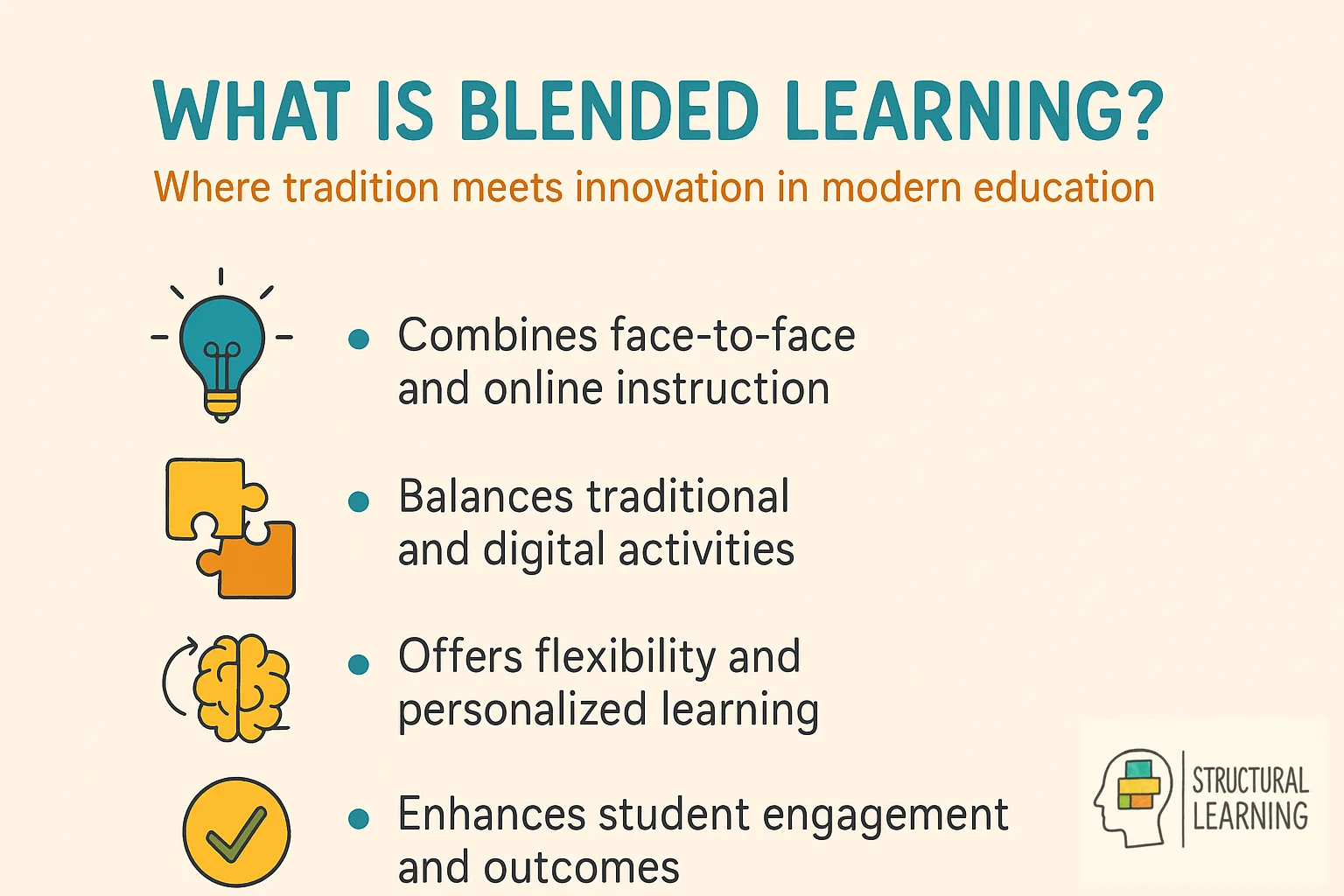
The thriving nature of blended learning in the educational landscape, particularly within university settings, indicates a shift towards a versatile and customized learning experience. The objective remains constant: to deliver superlative student outcomes, enhanced by the engagement and myriad possibilities facilitated by digital tools, in concert with the tried-and-true methods of traditional education.
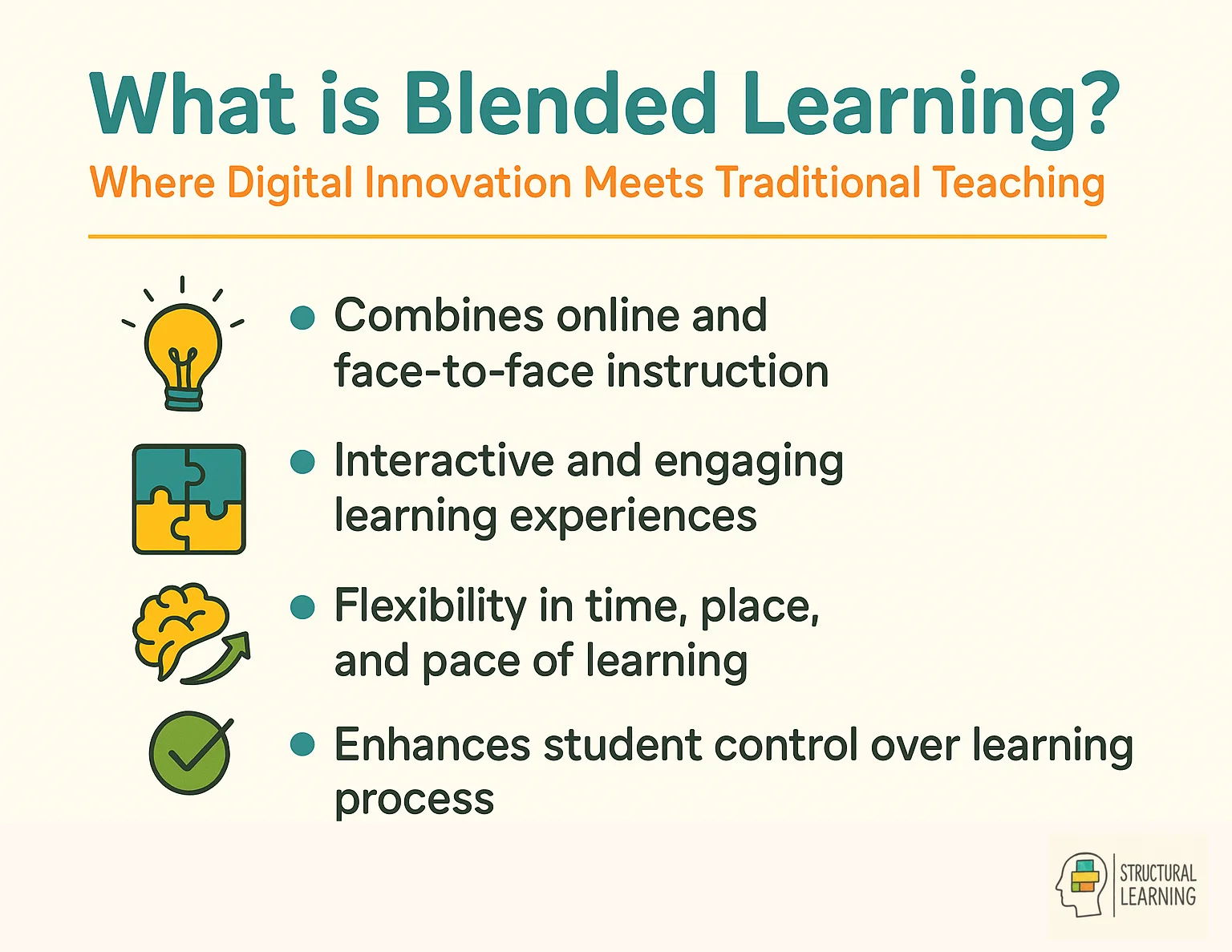
This article will unfold the multilayered aspects of blended teaching and learning, from its conception to current practices in both academic and corporate settings. Understanding its models and methodologies, we will weigh its benefits against its drawbacks, and review its implications on the educational landscape. Join us as we navigate through the intricate world of blended learning, a domain where tradition meets innovation to create a uniquely modern learning experience.
Within the discourse, terms like 'blized learning' and 'hybrid learning' are becoming increasingly entrenched. These expressions point to the confluence of the educational and technological realms, where online materials and activities are brought together with the more conventional modes of face-to-face pedagogy. This synergy between what is learnt digitally and what is experienced personally is aimed at enhancing student learning and widening the scope of educational opportunities.
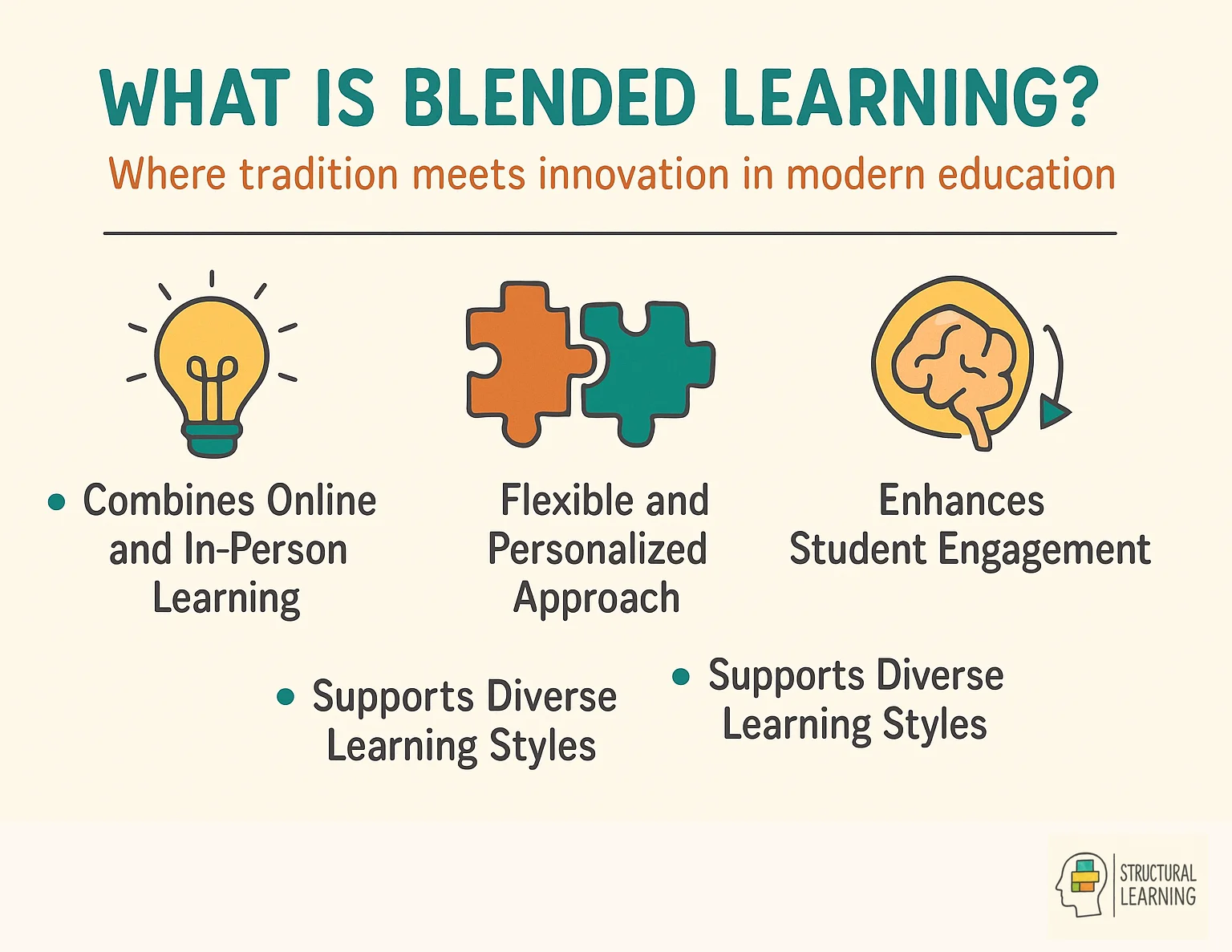
The term 'blended teaching' specifically underscores the pedagogical strategies that involve leveraging digital means alongside the formative practices characteristic of the classroom. This duality seeks to elevate traditional teaching by intertwining it with the multifaceted possibilities that modern educational technologies offer. Consequently, the blended learning environment becomes a composite, dynamic space where different modalities and tools coalesce to shape the learning process.

Blended teaching and learning have gradually surfaced as keystones in modern education, combining time-honored pedagogical practices with cutting-edge digital possibilities. This shift signifies a pedagogical evolution from the conventional to a boundary-blurring paradigm, where the digital and physical realms of learning coalesce.
Historically, the genesis of the blended learning model can be traced back to the early days of integrating online and on-campus learning. This phased introduction allowed educational institutions to explore the potential benefits of digital platforms while maintaining the established structure of in-person learning. As technology became more entrenched in our daily lives, the flexibility offered by blended teaching started to dissolve the constraints previously posed by physical locations, offering learners unprecedented access to education.
The arrival of blended learning marked a turning point, further spotlighted by the unforeseen circumstances brought about by the COVID-19 pandemic. The pandemic served as a catalyst, accelerating the adoption of predominantly online formats, and underlining the significance of blended learning approaches in maintaining the continuity of education. In this milieu, blended teaching has been understood to encompass the employment of digital strategies, not just as a supplemental tool, but as a foundational element alongside traditional classroom engagement.

The integration of technology into education has been pivotal in preparing learners to navigate a world where communication and business are increasingly mediated through digital means. In a blended learning environment, technology extends beyond a tool; it becomes an integral part of differentiated instruction. Digital resources, be it mobile apps or interactive online activities, contribute to an educational ecosystem where every student has the capacity to thrive.
Teachers leverage this integration by using technology, not only to direct lesson content but also to reinforce concepts with engaging activities and to conduct dynamic assessments and discussions. Educational tools like Quizlet and Kahoot have transformed mundane tasks into compelling experiences, while simultaneously offering insights into individual progress.
Blended learning models afford students a measure of autonomy over their educational journey, granting some control over time, place, path, and pace of learning. Such strategic combinations of online and in-person learning activities suggest an enhanced opportunity for teaching effectiveness.
In the quest for optimal integration, the interplay of media, method, and modality is crucial. Teachers orchestrating a blended learning environment aim to unite the strengths of in-person interaction with the boundless opportunities of online experiences, crafting a harmonious blend that accentuates student learning outcomes.
Blended teaching and learning embodies a progressive shift in the educational paradigm, where the focus is on optimizing the learning experience through the seamless integration of traditional classroom instruction and innovative online resources. This fusion offers marked benefits:
The educational tapestry is woven with richer textures when blending learning models are employed. These models bring forth:
Engagement is the heartbeat of student learning, and blended teaching methods invigorate it by:
Blended learning stands out with its adaptability and reach:
The interplay between various learning modalities, supported by educational technologies, carves out a learner-centric arena where engagement, accessibility, and flexibility are not just ideals, they are the everyday reality of the blended learning path.
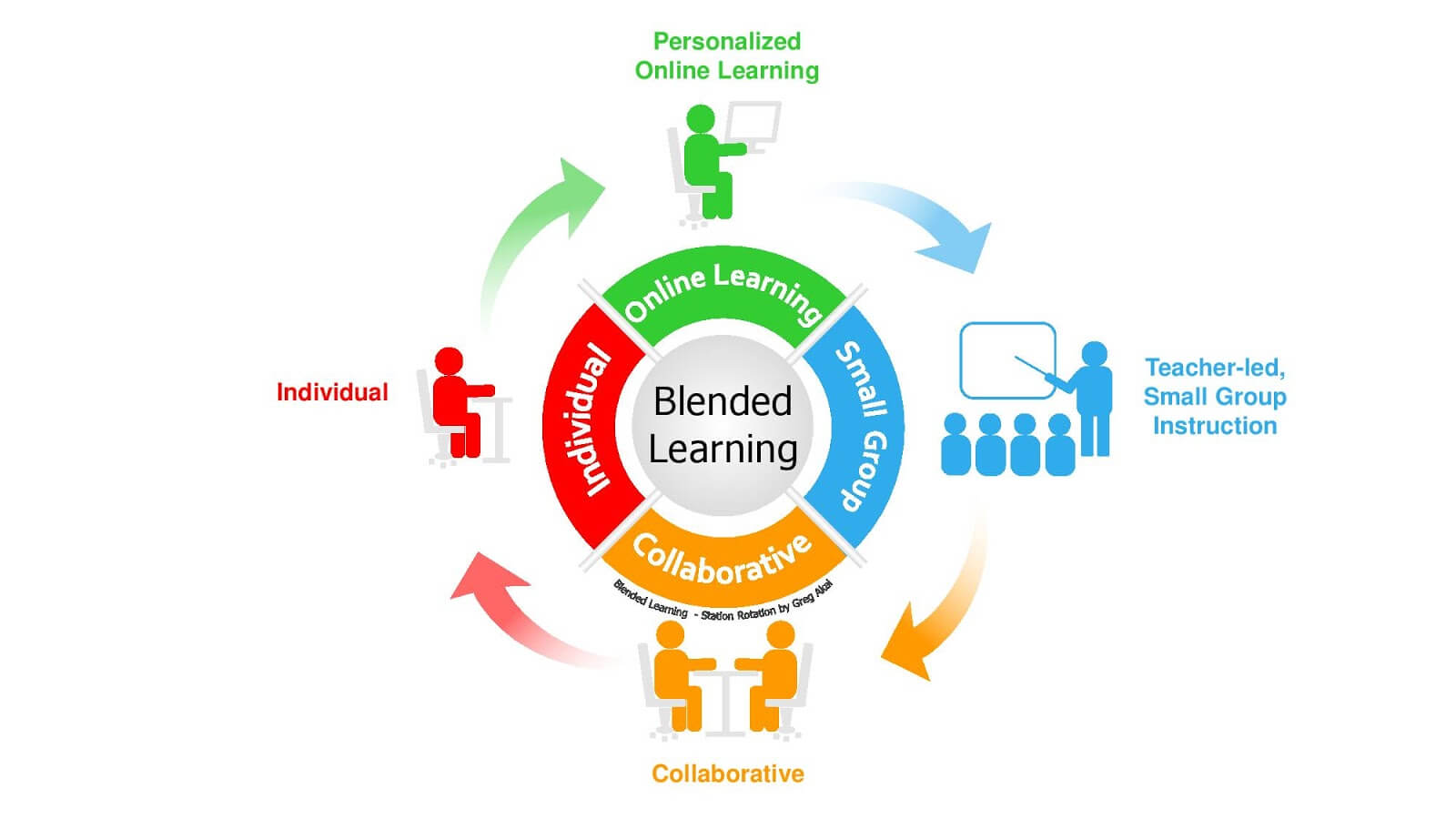
Blended teaching and learning, while progressive in its approach to education, is not devoid of challenges. The reliance on technological infrastructure is a considerable disadvantage. A seamless and impactful learning experience is contingent upon having access to reliable and up-to-date technical resources. Should this technology fail or be inaccessible, the learning experience can be significantly disrupted.
The flexibility that is one of the blended learning model's greatest strengths can also be a source of difficulty for learning professionals. The process of integrating various blended learning strategies and tools requires a delicate balance, which can be overwhelming for educators. Additionally, the transition often involves an integration of the costs associated with maintaining traditional classrooms, such as utilities and physical equipment, with digital resources, which, if not carefully considered and managed, can lead to increased expenditures.
Unequal access to necessary tools is another issue that cannot be overlooked. Differences in student access to online resources and unreliable internet connectivity can create disparities that hinder the effectiveness of a blended learning approach. Moreover, ineffective planning and execution of blended learning programs can compound these issues, emphasizing the importance of a well-thought-out strategy that ensures necessary tools and resources are accessible to all students.
A key requirement for effective implementation of blended learning is robust technological infrastructure, necessitating the physical presence of both teacher and student for certain activities. Policymakers and administrators must assess the unique needs and constraints within their educational environments to ensure alignment with training goals. The growing investment in educational technologies by modern organizations, including employee training software and digital adoption platforms, is indicative of the increasing commitment to blended learning.
Nonetheless, the model's success is squarely dependent on certain pillars: technological infrastructure must be readily available and steadfast, educators need to be prepared and receptive to new teaching modalities, and accessibility for students must be ensured. The best blended learning model is one that fits the learning goals, meets the needs of learners, and is supported by the available resources and infrastructure.

In an educational landscape that increasingly embraces diversity in teaching methods, the advent of blended learning models has provided a significant step forward in accommodating a spectrum of learning styles. These models synergize the traditional classroom setting with online components, fostering a Blipped Learning Approach that transcends the physical confines of the classic learning environment. The effectiveness of such a paradigm lies in the multitude of ways it enables students to engage with the curriculum, broadening both the scope and depth of the learning experience.
Core to the philosophy of blended learning is the principle that students can attain greater levels of achievement when given the chance to learn in various modalities; this refers not only to the instruction they receive but also to the methods through which they demonstrate their knowledge. Hence, the Blended Learning Model is not monolithic but exists in several permutations, including the Rotation, Flipped Classroom, Flex, and Enriched Virtual models. Each one provides a different fusion of online and in-person instruction, tailored to facilitate an enriching learning path and optimized learning outcomes.
Emblematic of the blended approach is the Rotation Model, where students pivot between different learning stations at pre-set intervals. This format incorporates online activities, in-person instruction, classroom discussions, and individual learning times, thus catering to a diversity of preferences and needs within a classroom. This eclectic combination allows for differentiated instruction, as students may be shifted dynamically to suit their individual learning styles and paces. Class time is strategically segmented to enable personalized instruction, the utilization of educational technologies, and hands-on activities, merging the autonomy of online learning with the collaborative benefits of classroom interactions.
The Flex Model, conversely, places significant control in the hands of the students, letting them carve out a personalized and self-directed learning path. Online learning is the backbone of this method, supplemented by in-person support when needed. Instructors in the Flex Model adopt a coaching stance, facilitating student learning rather than leading it directly, aiding learners only as they encounter challenges.
This model, characterized by its fluidity, is conducive to fostering independent learning skills, as students decide not only the pace but also, in some cases, the sequence of their learning process. As such, the Flex Model aligns closely with modern educational technologies, thriving in a blended learning environment where students shape their own academic journeys.
Learners who exhibit high degrees of self-motivation and a thirst for a deeper dive into subject matter may find the Self-blend Model particularly advantageous. Here, learners supplement their learning experience with an array of online materials such as webinars, video tutorials, or industry-specific readings, often accessed through a comprehensive Learning Management System (LMS).
This self-blend approach encourages a polylectic engagement with content, enabling learners to explore beyond the boundaries of the curriculum and further their expertise through multifaceted resources. The model epitomizes the underpinning essence of a Blended Approach, a robust vehicle for personalized and curated educational exploration.
Finally, there is the Online Lab Model, which hinges on digital exploration and discovery, often with minimal instructor oversight. This model complements the learning experience by enabling access to a diverse range of digital content prior to, during, or following in-person instruction.
Emphasizing a self-paced learning style, the Online Lab Model empowers students to independently pursue knowledge, while still being underpinned by the structured support of a LMS. Suited for the technologically adept learner, the Online Lab Model facilitates a ubiquitous learning experience, allowing for educational engagement anytime, anywhere, across a variety of mobile devices.
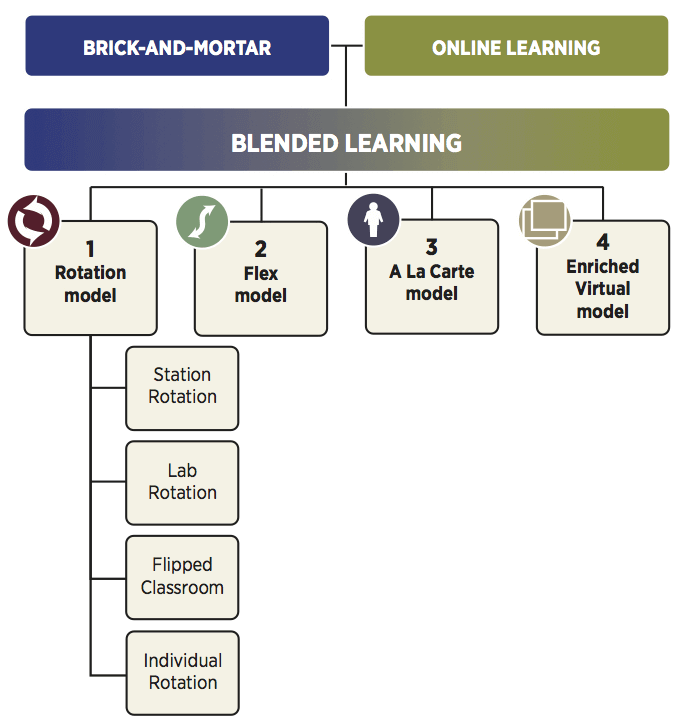
Key to this integrative approach is the multiplicity of teaching methodologies, which amalgamates the traditional classroom dynamics with the digital fluence of online learning.
The crux of blended learning lies not simply in the adoption of technology, but rather in its strategic application to create immersive, interactive, and individualized learning experiences. By incorporating online tools for communication, collaboration, and extending educational engagement beyond the confines of the classroom, blended learning sets the stage for the development of crucial 21st-century skills, including critical thinking, problem-solving, and fortifying learners’ global awareness.
The foundation of a successful blended learning initiative is anchored firmly in the clarity of its educational aims. These goals typically encompass an aspiration to heighten learner engagement, augmenting autonomy in the educational process, and curating avenues for collective or person learning endeavors that hone social and interactive proficiencies.
Deciding upon the most suitable blended learning model is an exercise calibrated to the alignment with these comprehensive objectives, taking into consideration the nuances of models like the flipped classroom or the flex model. Each model proposes distinct strategies and operational workflows conducive to reaching the delineated objectives.
The optimization of blended learning outcomes is contingent upon a nuanced selection of a model that not only dovetails with the learning community's aspirations but is also sustainable considering available resources and technological infrastructure.
Crafting a blended learning program catalyzes the interplay between the virtual and the physical classroom, granting learners the sovereignty to steer their learning trajectory. Structurally, the learning cycle in a blended format is orchestrated to encompass phases of pre-learning, which primes the learners; interactive, instructor-led sessions that delve into content and inspire discourse; and post-learning activities where assessments and data analytics offer insight into the efficacy of the program.
The emphasis on accessibility within blended learning's design is paramount, ensuring equitable content access for all learners and honing the learning experience to meet the distinct needs of each individual. By incorporating purpose-selected online tools, the blended teaching paradigm strives not merely to complement but to extend classroom interactions, nurturing skills that are vital for thriving in an increasingly interconnected and complex world.
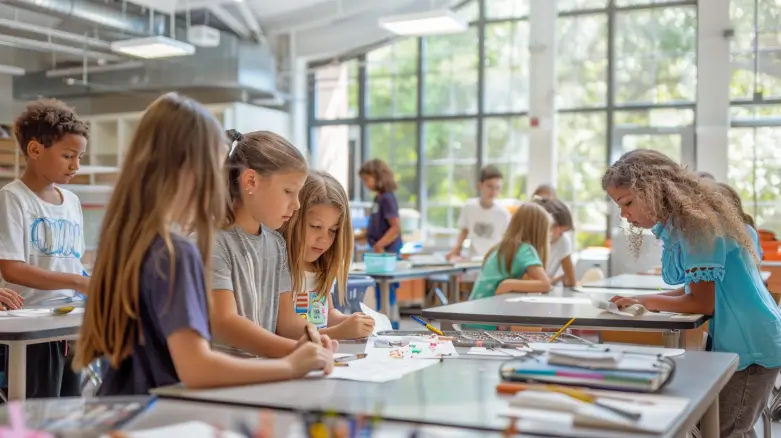
The backbone of an effective blended learning environment is the judicious choice of compatible technological implements. This may comprise a spectrum of digital curricula for instruction amplification, interactive online platforms to engender digital cooperation amongst learners, and systems like LMS that neatly encapsulate the learning content and assessment tools.
These technological substrates should be selected with an eye to galvanizing learner participation, catering to the diversity of learning styles, and nurturing independent learning competencies. The technological arsenal deployed in a blended teaching ecosystem is both a driver and enabler of educational progress and must be thoughtfully curated to align with the overarching instructional goals.
Observation and appraisal are key to the cyclical refinement process of a blended learning course. A meticulous monitoring of learner progression throughout the program's tenure, coupled with exhaustive assessments at its culmination, is essential to gauge the program's success, discern knowledge lacunas, and tailor future learning encounters.
LMS platforms often provide the infrastructure to facilitate such examinations and data collation, enabling a comprehensive analysis of the blended learning program's footprint. Through systematic evaluation, it is feasible to confirm the congruence between learning goals and actual educational outcomes, thus ensuring that the blended learning model services the pedagogic needs effectively. Inherent within this process is the anticipation and resolution of technical conundrums that may arise owing to the reliance on infallible and current technological solutions to deliver a meaningful learning experience.
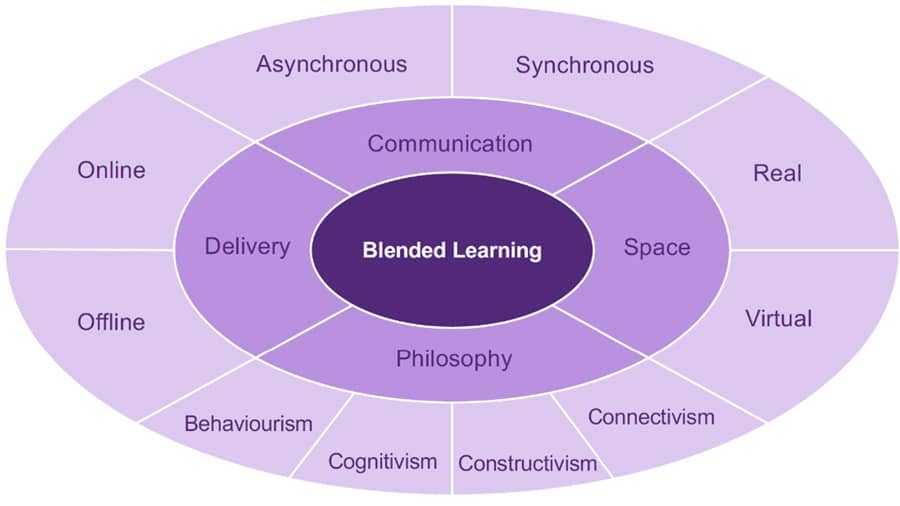
The following studies collectively highlight the potential advantages and challenges of blended learning, emphasizing the importance of integrating technology, designing interactive and learner-centered activities, and effectively balancing online and traditional teaching methods.
1. Abdelraheem, A. Y. (2014). Enhancing Students' Learning and Self-Efficacy through Blended Learning in a Teachers' Program. Journal on Educational Technology, 10, 29-39.
Summary: This study examines the impact of blended learning strategies on student learning and self-efficacy in teacher education programs. The integration of technology and traditional classroom methods showed significant improvements in student grades and engagement, although self-efficacy differences were not significant.
2. Zhao, M., Liu, Z., Zhao, R., & Liu, Y. (2021). Application and Practice of Blended Teaching in Colleges and Universities. Proceedings of the 2021 5th International Seminar on Education, Management and Social Sciences (ISEMSS 2021).
Summary: This paper discusses the challenges and effective methods for improving the quality of blended teaching in higher education. It highlights the importance of learner-centered design, interactive strategies, and formative assessment to enhance online learning environments and classroom time.
3. Andreyeva, N. (2020). Pedagogy of Effective Blended Learning. Journal of Modern Foreign Psychology, 9, 8-20.
Summary: Andreyeva presents a model for effective blended learning, emphasizing personalization, active learning, and self-regulation. The study identifies key factors such as goal-oriented design, flexible learning, and differentiated teaching strategies that contribute to successful blended learning outcomes.
4. Yang, H., Zhu, S., & MacLeod, J. (2016). Collaborative Teaching Approaches: Extending Current Blended Learning Models.
Summary: This study reviews and expands upon existing blended learning models by introducing collaborative teaching approaches like on-site and off-site leadership and co-teaching. The findings suggest that these models enhance teaching strategies and improve online discussions and classroom interactions.
5. S. di. (2022). Effectiveness of College English Blended Teaching Based on Foreign Language Teaching Platforms in Universities. International Journal of Science and Engineering Applications.
Summary: This research explores the effectiveness of blended teaching for college English courses, emphasizing the integration of technology and traditional methods. The study finds that blended learning improves student engagement and academic performance by leveraging online learning activities and classroom interactions.
Blended teaching and learning represent an instructional paradigm that seeks to harness the capacity of digital tools while maintaining the irreplaceable value of face-to-face interaction. It is an approach designed to forge synchronization between online digital strategies and the traditional, time-honored practices found within the regular classroom. At its core, this way of teaching is focused on combining an indispensable human element with technological advancements to enrich the learning experience.
In practical terms, blended instruction might manifest itself through a variety of models. For some, it entails incorporating an online component wherein students engage in tasks or review materials outside of class time, returning to the classroom for in-depth discussion and hands-on activities that build upon the online learning. This approach promises not only to augment the traditional learning model but also to cultivate a more individualized and differentiated learning path for each student.

The thriving nature of blended learning in the educational landscape, particularly within university settings, indicates a shift towards a versatile and customized learning experience. The objective remains constant: to deliver superlative student outcomes, enhanced by the engagement and myriad possibilities facilitated by digital tools, in concert with the tried-and-true methods of traditional education.

This article will unfold the multilayered aspects of blended teaching and learning, from its conception to current practices in both academic and corporate settings. Understanding its models and methodologies, we will weigh its benefits against its drawbacks, and review its implications on the educational landscape. Join us as we navigate through the intricate world of blended learning, a domain where tradition meets innovation to create a uniquely modern learning experience.
Within the discourse, terms like 'blized learning' and 'hybrid learning' are becoming increasingly entrenched. These expressions point to the confluence of the educational and technological realms, where online materials and activities are brought together with the more conventional modes of face-to-face pedagogy. This synergy between what is learnt digitally and what is experienced personally is aimed at enhancing student learning and widening the scope of educational opportunities.

The term 'blended teaching' specifically underscores the pedagogical strategies that involve leveraging digital means alongside the formative practices characteristic of the classroom. This duality seeks to elevate traditional teaching by intertwining it with the multifaceted possibilities that modern educational technologies offer. Consequently, the blended learning environment becomes a composite, dynamic space where different modalities and tools coalesce to shape the learning process.

Blended teaching and learning have gradually surfaced as keystones in modern education, combining time-honored pedagogical practices with cutting-edge digital possibilities. This shift signifies a pedagogical evolution from the conventional to a boundary-blurring paradigm, where the digital and physical realms of learning coalesce.
Historically, the genesis of the blended learning model can be traced back to the early days of integrating online and on-campus learning. This phased introduction allowed educational institutions to explore the potential benefits of digital platforms while maintaining the established structure of in-person learning. As technology became more entrenched in our daily lives, the flexibility offered by blended teaching started to dissolve the constraints previously posed by physical locations, offering learners unprecedented access to education.
The arrival of blended learning marked a turning point, further spotlighted by the unforeseen circumstances brought about by the COVID-19 pandemic. The pandemic served as a catalyst, accelerating the adoption of predominantly online formats, and underlining the significance of blended learning approaches in maintaining the continuity of education. In this milieu, blended teaching has been understood to encompass the employment of digital strategies, not just as a supplemental tool, but as a foundational element alongside traditional classroom engagement.

The integration of technology into education has been pivotal in preparing learners to navigate a world where communication and business are increasingly mediated through digital means. In a blended learning environment, technology extends beyond a tool; it becomes an integral part of differentiated instruction. Digital resources, be it mobile apps or interactive online activities, contribute to an educational ecosystem where every student has the capacity to thrive.
Teachers leverage this integration by using technology, not only to direct lesson content but also to reinforce concepts with engaging activities and to conduct dynamic assessments and discussions. Educational tools like Quizlet and Kahoot have transformed mundane tasks into compelling experiences, while simultaneously offering insights into individual progress.
Blended learning models afford students a measure of autonomy over their educational journey, granting some control over time, place, path, and pace of learning. Such strategic combinations of online and in-person learning activities suggest an enhanced opportunity for teaching effectiveness.
In the quest for optimal integration, the interplay of media, method, and modality is crucial. Teachers orchestrating a blended learning environment aim to unite the strengths of in-person interaction with the boundless opportunities of online experiences, crafting a harmonious blend that accentuates student learning outcomes.
Blended teaching and learning embodies a progressive shift in the educational paradigm, where the focus is on optimizing the learning experience through the seamless integration of traditional classroom instruction and innovative online resources. This fusion offers marked benefits:
The educational tapestry is woven with richer textures when blending learning models are employed. These models bring forth:
Engagement is the heartbeat of student learning, and blended teaching methods invigorate it by:
Blended learning stands out with its adaptability and reach:
The interplay between various learning modalities, supported by educational technologies, carves out a learner-centric arena where engagement, accessibility, and flexibility are not just ideals, they are the everyday reality of the blended learning path.

Blended teaching and learning, while progressive in its approach to education, is not devoid of challenges. The reliance on technological infrastructure is a considerable disadvantage. A seamless and impactful learning experience is contingent upon having access to reliable and up-to-date technical resources. Should this technology fail or be inaccessible, the learning experience can be significantly disrupted.
The flexibility that is one of the blended learning model's greatest strengths can also be a source of difficulty for learning professionals. The process of integrating various blended learning strategies and tools requires a delicate balance, which can be overwhelming for educators. Additionally, the transition often involves an integration of the costs associated with maintaining traditional classrooms, such as utilities and physical equipment, with digital resources, which, if not carefully considered and managed, can lead to increased expenditures.
Unequal access to necessary tools is another issue that cannot be overlooked. Differences in student access to online resources and unreliable internet connectivity can create disparities that hinder the effectiveness of a blended learning approach. Moreover, ineffective planning and execution of blended learning programs can compound these issues, emphasizing the importance of a well-thought-out strategy that ensures necessary tools and resources are accessible to all students.
A key requirement for effective implementation of blended learning is robust technological infrastructure, necessitating the physical presence of both teacher and student for certain activities. Policymakers and administrators must assess the unique needs and constraints within their educational environments to ensure alignment with training goals. The growing investment in educational technologies by modern organizations, including employee training software and digital adoption platforms, is indicative of the increasing commitment to blended learning.
Nonetheless, the model's success is squarely dependent on certain pillars: technological infrastructure must be readily available and steadfast, educators need to be prepared and receptive to new teaching modalities, and accessibility for students must be ensured. The best blended learning model is one that fits the learning goals, meets the needs of learners, and is supported by the available resources and infrastructure.

In an educational landscape that increasingly embraces diversity in teaching methods, the advent of blended learning models has provided a significant step forward in accommodating a spectrum of learning styles. These models synergize the traditional classroom setting with online components, fostering a Blipped Learning Approach that transcends the physical confines of the classic learning environment. The effectiveness of such a paradigm lies in the multitude of ways it enables students to engage with the curriculum, broadening both the scope and depth of the learning experience.
Core to the philosophy of blended learning is the principle that students can attain greater levels of achievement when given the chance to learn in various modalities; this refers not only to the instruction they receive but also to the methods through which they demonstrate their knowledge. Hence, the Blended Learning Model is not monolithic but exists in several permutations, including the Rotation, Flipped Classroom, Flex, and Enriched Virtual models. Each one provides a different fusion of online and in-person instruction, tailored to facilitate an enriching learning path and optimized learning outcomes.
Emblematic of the blended approach is the Rotation Model, where students pivot between different learning stations at pre-set intervals. This format incorporates online activities, in-person instruction, classroom discussions, and individual learning times, thus catering to a diversity of preferences and needs within a classroom. This eclectic combination allows for differentiated instruction, as students may be shifted dynamically to suit their individual learning styles and paces. Class time is strategically segmented to enable personalized instruction, the utilization of educational technologies, and hands-on activities, merging the autonomy of online learning with the collaborative benefits of classroom interactions.
The Flex Model, conversely, places significant control in the hands of the students, letting them carve out a personalized and self-directed learning path. Online learning is the backbone of this method, supplemented by in-person support when needed. Instructors in the Flex Model adopt a coaching stance, facilitating student learning rather than leading it directly, aiding learners only as they encounter challenges.
This model, characterized by its fluidity, is conducive to fostering independent learning skills, as students decide not only the pace but also, in some cases, the sequence of their learning process. As such, the Flex Model aligns closely with modern educational technologies, thriving in a blended learning environment where students shape their own academic journeys.
Learners who exhibit high degrees of self-motivation and a thirst for a deeper dive into subject matter may find the Self-blend Model particularly advantageous. Here, learners supplement their learning experience with an array of online materials such as webinars, video tutorials, or industry-specific readings, often accessed through a comprehensive Learning Management System (LMS).
This self-blend approach encourages a polylectic engagement with content, enabling learners to explore beyond the boundaries of the curriculum and further their expertise through multifaceted resources. The model epitomizes the underpinning essence of a Blended Approach, a robust vehicle for personalized and curated educational exploration.
Finally, there is the Online Lab Model, which hinges on digital exploration and discovery, often with minimal instructor oversight. This model complements the learning experience by enabling access to a diverse range of digital content prior to, during, or following in-person instruction.
Emphasizing a self-paced learning style, the Online Lab Model empowers students to independently pursue knowledge, while still being underpinned by the structured support of a LMS. Suited for the technologically adept learner, the Online Lab Model facilitates a ubiquitous learning experience, allowing for educational engagement anytime, anywhere, across a variety of mobile devices.

Key to this integrative approach is the multiplicity of teaching methodologies, which amalgamates the traditional classroom dynamics with the digital fluence of online learning.
The crux of blended learning lies not simply in the adoption of technology, but rather in its strategic application to create immersive, interactive, and individualized learning experiences. By incorporating online tools for communication, collaboration, and extending educational engagement beyond the confines of the classroom, blended learning sets the stage for the development of crucial 21st-century skills, including critical thinking, problem-solving, and fortifying learners’ global awareness.
The foundation of a successful blended learning initiative is anchored firmly in the clarity of its educational aims. These goals typically encompass an aspiration to heighten learner engagement, augmenting autonomy in the educational process, and curating avenues for collective or person learning endeavors that hone social and interactive proficiencies.
Deciding upon the most suitable blended learning model is an exercise calibrated to the alignment with these comprehensive objectives, taking into consideration the nuances of models like the flipped classroom or the flex model. Each model proposes distinct strategies and operational workflows conducive to reaching the delineated objectives.
The optimization of blended learning outcomes is contingent upon a nuanced selection of a model that not only dovetails with the learning community's aspirations but is also sustainable considering available resources and technological infrastructure.
Crafting a blended learning program catalyzes the interplay between the virtual and the physical classroom, granting learners the sovereignty to steer their learning trajectory. Structurally, the learning cycle in a blended format is orchestrated to encompass phases of pre-learning, which primes the learners; interactive, instructor-led sessions that delve into content and inspire discourse; and post-learning activities where assessments and data analytics offer insight into the efficacy of the program.
The emphasis on accessibility within blended learning's design is paramount, ensuring equitable content access for all learners and honing the learning experience to meet the distinct needs of each individual. By incorporating purpose-selected online tools, the blended teaching paradigm strives not merely to complement but to extend classroom interactions, nurturing skills that are vital for thriving in an increasingly interconnected and complex world.

The backbone of an effective blended learning environment is the judicious choice of compatible technological implements. This may comprise a spectrum of digital curricula for instruction amplification, interactive online platforms to engender digital cooperation amongst learners, and systems like LMS that neatly encapsulate the learning content and assessment tools.
These technological substrates should be selected with an eye to galvanizing learner participation, catering to the diversity of learning styles, and nurturing independent learning competencies. The technological arsenal deployed in a blended teaching ecosystem is both a driver and enabler of educational progress and must be thoughtfully curated to align with the overarching instructional goals.
Observation and appraisal are key to the cyclical refinement process of a blended learning course. A meticulous monitoring of learner progression throughout the program's tenure, coupled with exhaustive assessments at its culmination, is essential to gauge the program's success, discern knowledge lacunas, and tailor future learning encounters.
LMS platforms often provide the infrastructure to facilitate such examinations and data collation, enabling a comprehensive analysis of the blended learning program's footprint. Through systematic evaluation, it is feasible to confirm the congruence between learning goals and actual educational outcomes, thus ensuring that the blended learning model services the pedagogic needs effectively. Inherent within this process is the anticipation and resolution of technical conundrums that may arise owing to the reliance on infallible and current technological solutions to deliver a meaningful learning experience.

The following studies collectively highlight the potential advantages and challenges of blended learning, emphasizing the importance of integrating technology, designing interactive and learner-centered activities, and effectively balancing online and traditional teaching methods.
1. Abdelraheem, A. Y. (2014). Enhancing Students' Learning and Self-Efficacy through Blended Learning in a Teachers' Program. Journal on Educational Technology, 10, 29-39.
Summary: This study examines the impact of blended learning strategies on student learning and self-efficacy in teacher education programs. The integration of technology and traditional classroom methods showed significant improvements in student grades and engagement, although self-efficacy differences were not significant.
2. Zhao, M., Liu, Z., Zhao, R., & Liu, Y. (2021). Application and Practice of Blended Teaching in Colleges and Universities. Proceedings of the 2021 5th International Seminar on Education, Management and Social Sciences (ISEMSS 2021).
Summary: This paper discusses the challenges and effective methods for improving the quality of blended teaching in higher education. It highlights the importance of learner-centered design, interactive strategies, and formative assessment to enhance online learning environments and classroom time.
3. Andreyeva, N. (2020). Pedagogy of Effective Blended Learning. Journal of Modern Foreign Psychology, 9, 8-20.
Summary: Andreyeva presents a model for effective blended learning, emphasizing personalization, active learning, and self-regulation. The study identifies key factors such as goal-oriented design, flexible learning, and differentiated teaching strategies that contribute to successful blended learning outcomes.
4. Yang, H., Zhu, S., & MacLeod, J. (2016). Collaborative Teaching Approaches: Extending Current Blended Learning Models.
Summary: This study reviews and expands upon existing blended learning models by introducing collaborative teaching approaches like on-site and off-site leadership and co-teaching. The findings suggest that these models enhance teaching strategies and improve online discussions and classroom interactions.
5. S. di. (2022). Effectiveness of College English Blended Teaching Based on Foreign Language Teaching Platforms in Universities. International Journal of Science and Engineering Applications.
Summary: This research explores the effectiveness of blended teaching for college English courses, emphasizing the integration of technology and traditional methods. The study finds that blended learning improves student engagement and academic performance by leveraging online learning activities and classroom interactions.